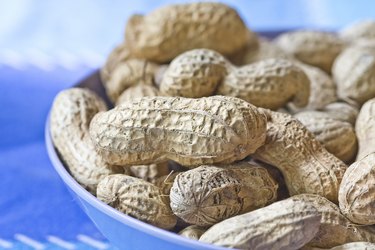
L-lysine is an essential amino acid involved in the production of collagen for bone growth and wound healing; the breakdown of fats into energy; and the absorption of calcium. Although almost all foods that contain protein also contain l-lysine, nuts feature comparatively low levels. In the November 2006 issue of the "British Journal of Nutrition," a team of researchers led by nutritionist Gemma Brufau, Ph.D. describe how the l-lysine content of nuts relates to your risk of cardiovascular and other diseases.
Function of L-lysine and L-arginine
Video of the Day
According to Dr. Brufau, scientists consider the l-lysine content in nuts and other foods in terms of its ratio to another amino acid, l-arginine. L-arginine plays a role in blood vessel dilation, growth hormone production, immune system function and maintenance of pH balance. L-lysine and l-arginine compete with one another for absorption and generally exert opposing effects within the body. Nuts number among the few foods that contain high amounts of l-arginine and low amounts of l-lysine.
Video of the Day
Significance to Health
The high ratio of l-arginine to l-lysine means that nuts are good choices for people with medical problems involving the heart or blood vessels, such as congestive heart failure, chest pain, elevated blood pressure, coronary artery disease, peripheral vascular disease, vascular dementia and erectile dysfunction. By contrast, the opposite recommendation -- a diet that avoids nuts and promotes foods high in L-lysine and low in arginine -- has become a popular recommendations for people with herpes. In the 2007 edition of "Integrative Medicine," University of Wisconsin professor David Rakel, M.D. explains that test tube studies show that arginine promotes the growth of the virus that causes herpes. However, Rakel cautions, "clinical studies show mixed results."
Types of Nuts
Brafau says that both tree nuts -- like almonds, walnuts, pistachios and macadamias, and ground nuts -- like peanuts, exhibit high ratios of l-arginine to l-lysine. However, there are variations between different types of nuts. For example, macadamia nuts top out among all nuts at a ratio of 78 to 1. By contrast, pistachio nuts offer the lowest ratio at 1.8 to 1. Other popular nuts in descending order include: Walnuts 5.4 to 1, hazelnuts 5.3 to 1, pine nuts 4.5 to 1, brazil nuts 4.4 to 1, almonds 4.2 to 1, pecans 4.1 to 1, peanuts 3.3 to 1 and cashews 2.3 to 1.
How Nuts Compare
The United States Department of Agriculture assigns nuts to the same food group as meat, poultry, fish, dry beans and eggs. Nuts and dry beans both feature high ratios of l-arginine to l-lysine while fish, meat, poultry follow the opposite pattern. Eggs are evenly balanced at a ratio of 1:1 between l-arginine and l-lysine. The USDA recommends choosing nuts "frequently" to balance out the more popular choices of meat and poultry. Since nuts are high in calories, a 1.5-ounce portion of nuts -- about one-third cup -- replaces a 3- to 5-ounce portion of meat or poultry.
Points to Consider
The health benefits of nuts cannot be solely attributed to their relatively low levels of lysine. In addition to offering a high ratio of l-arginine to l-lysine, nuts contain other nutrients like monounsaturated fat, dietary fiber and vitamin E that also contribute to heart and blood vessel health. Although nuts are high in fat and calories, people who eat them have lower cholesterol, blood sugar and body weight compared to those who do not.